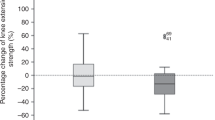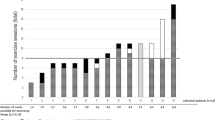Abstract
The positive effects of physical and sports therapy for strain dependent physical practice and improved quality of life (QoL) are well known. Nevertheless, the available capacities and problem-oriented therapies in the setting of hematopoietic stem cell transplantation (HSCT) are limited. We conducted a prospective, randomized study among 42 HSCT recipients in order to investigate the influence of exergaming on Nintendo Wii® or classical physiotherapy (PT) on physical fitness and psychological well-being. The trial included evaluation of muscle strength, endurance, physical activity, distress, QoL, anxiety, and depression. Within the first 2 weeks after HSCT endurance, muscle strength and physical well-being decreased, while the value of distress increased significantly in both groups. However, exergaming on Nintendo Wii® resulted in a decrease of anxiety and depression and improved emotional well-being, while the PT group showed a contrariwise pattern of these features. Analysis of the FACT-BMT revealed a decline of QoL domains 2 and 4 weeks after HSCT and an improvement afterwards. The decrease of functional status after HSCT was accompanied by a drop of QoL and an increase of distress in both groups. However, our prospective study demonstrates that exergaming using the Nintendo Wii® is feasible and well tolerated in HSCT recipients.
This is a preview of subscription content, access via your institution
Access options
Subscribe to this journal
Receive 12 print issues and online access
$259.00 per year
only $21.58 per issue
Buy this article
- Purchase on Springer Link
- Instant access to full article PDF
Prices may be subject to local taxes which are calculated during checkout

Similar content being viewed by others
References
Dimeo F, Rumberger BG, Keul J. Aerobic exercise as therapy for cancer fatigue. Med Sci Sports Exerc. 1998;30:475–8.
Winningham ML. Strategies for managing cancer-related fatigue syndrome: a rehabilitation approach. Cancer. 2001;92:988–97.
Wiskemann J, Huber G. Physical exercise as adjuvant therapy for patients undergoing hematopoietic stem cell transplantation. Bone Marrow Transplant. 2008;41:321–9.
Wiskemann J, Dreger P, Schwerdtfeger R, Bondong A, Huber G, Kleindienst N, et al. Effects of a partly self-administered exercise program before, during, and after allogeneic stem cell transplantation. Blood. 2011;117:2604–13.
Bogg TFT, Broderick C, Shaw P, Cohn R, Naumann FL. Feasibility of an inpatient exercise intervention for children undergoing hematopoietic stem cell transplant. Pediatr Transplant. 2015;19:925–31.
Persoon S, Kersten MJ, van der Weiden K, Buffart LM, Nollet F, Brug J, et al. Effects of exercise in patients treated with stem cell transplantation for a hematologic malignancy: a systematic review and meta-analysis. Cancer Treat Rev. 2013;39:682–90.
Dimeo F, Fetscher S, Lange W, Mertelsmann R, Keul J. Effects of aerobic exercise on the physical performance and incidence of treatment-related complications after high-dose chemotherapy. Blood. 1997;90:3390–4.
Kim S-D, Kim H-S. A series of bed exercises to improve lymphocyte count in allogeneic bone marrow transplantation patients. Eur J Cancer Care (Engl). 2006;15:453–7.
Robinson J, Dixon J, Macsween A, van Schaik P, Martin D. The effects of exergaming on balance, gait, technology acceptance and flow experience in people with multiple sclerosis: a randomized controlled trial. BMC Sports Sci Med Rehabil. 2015;7:8
Mat Rosly M, Mat Rosly H, Davis Oam GM, Husain R, Hasnan N. Exergaming for individuals with neurological disability: a systematic review. Disabil Rehabil. 2017;39:727–35.
Tsuda K, Sudo K, Goto G, Takai M, Itokawa T, Isshiki T, et al. A feasibility study of virtual reality exercise in elderly patients with hematologic malignancies receiving chemotherapy. Intern Med. 2016;55:347–52.
Solway S, Brooks D, Lacasse Y, Thomas S. A qualitative systematic overview of the measurement properties of functional walk tests used in the cardiorespiratory domain. Chest. 2001;119:256–70.
Kramer M, Heussner P, Herzberg PY, Andree H, Hilgendorf I, Leithaeuser M, et al. Validation of the grip test and human activity profile for evaluation of physical performance during the intermediate phase after allogeneic hematopoietic stem cell transplantation. Support Care Cancer. 2013;21:1121–9.
Herzberg PY, Heussner P, Mumm FHA, Horak M, Hilgendorf I, Harsdorf Svon, et al. Validation of the human activity profile questionnaire in patients after allogeneic hematopoietic stem cell transplantation. Biol Blood Marrow Transplant. 2010;16:1707–17.
McQuellon RP, Russell GB, Cella DF, Craven BL, Brady M, Bonomi A, et al. Quality of life measurement in bone marrow transplantation: development of the Functional Assessment of Cancer Therapy-Bone Marrow Transplant (FACT-BMT) scale. Bone Marrow Transplant. 1997;19:357–68.
Stewart AL, Hays RD, Ware JE Jr. The MOS short-form general health survey. Reliability and validity in a patient population. Med Care. 1988;26:724–35.
Zigmond AS, Snaith RP. The hospital anxiety and depression scale. Acta Psychiatr Scand. 1983;67:361–70.
Singer S, Kuhnt S, Gotze H, Hauss J, Hinz A, Liebmann A, et al. Hospital anxiety and depression scale cutoff scores for cancer patients in acute care. Br J Cancer. 2009;100:908–12.
Holland JC, Andersen B, Breitbart WS, Dabrowski M, Dudley MM, Fleishman S, et al. Distress management. J Natl Compr Canc Netw. 2007;5:66–98.
Bevans M, Wehrlen L, Prachenko O, Soeken K, Zabora J, Wallen GR. Distress screening in allogeneic hematopoietic stem cell (HSCT) caregivers and patients. Psychooncology. 2011;20:615–22.
Baumann FT, Kraut L, Schule K, Bloch W, Fauser AA. A controlled randomized study examining the effects of exercise therapy on patients undergoing haematopoietic stem cell transplantation. Bone Marrow Transplant. 2010;45:355–62.
Baumann FT, Zopf EM, Nykamp E, Kraut L, Schule K, Elter T, et al. Physical activity for patients undergoing an allogeneic hematopoietic stem cell transplantation: benefits of a moderate exercise intervention. Eur J Haematol. 2011;87:148–56.
DeFor TE, Burns LJ, Gold E-MA, Weisdorf DJ. A randomized trial of the effect of a walking regimen on the functional status of 100 adult allogeneic donor hematopoietic cell transplant patients. Biol Blood Marrow Transplant. 2007;13:948–55.
Takekiyo T, Dozono K, Mitsuishi T, Murayama Y, Maeda A, Nakano N, et al. Effect of exercise therapy on muscle mass and physical functioning in patients undergoing allogeneic hematopoietic stem cell transplantation. Support Care Cancer. 2015;23:985–92.
Rosipal NC, Mingle L, Smith J, Morris GS. Assessment of voluntary exercise behavior and active video gaming among adolescent and young adult patients during hematopoietic stem cell transplantation. J Pediatr Oncol Nurs. 2013;30:24–33.
Jahn P, Lakowa N, Landenberger M, Vordermark D, Stoll O. InterACTIV: an exploratory study of the use of a game console to promote physical activation of hospitalized adult patients with cancer. Oncol Nurs Forum. 2012;39:E84–90.
Foley L, Maddison R. Use of active video games to increase physical activity in children: a (virtual) reality? Pediatr Exerc Sci. 2010;22:7–20.
Acknowledgements
We are grateful to our study participants and appreciate our physical therapists for helping us conduct the study.
Author information
Authors and Affiliations
Corresponding author
Ethics declarations
Conflict of interest
The authors declare that they have no conflict of interest.
Additional information
Helge Schumacher and Sabrina Stüwe contributed equally to this work.
Rights and permissions
About this article
Cite this article
Schumacher, H., Stüwe, S., Kropp, P. et al. A prospective, randomized evaluation of the feasibility of exergaming on patients undergoing hematopoietic stem cell transplantation. Bone Marrow Transplant 53, 584–590 (2018). https://doi.org/10.1038/s41409-017-0070-8
Received:
Revised:
Accepted:
Published:
Issue Date:
DOI: https://doi.org/10.1038/s41409-017-0070-8
This article is cited by
-
Psychosocial distress in young adults surviving hematological malignancies: a pilot study
Journal of Cancer Research and Clinical Oncology (2023)
-
Inspiratory muscle training in addition to conventional physical rehabilitation in hospitalized patients undergoing hematopoietic stem cell transplantation: a randomized controlled trial
Supportive Care in Cancer (2022)
-
Use of active video games with or without videoconferencing on health outcomes in adolescent and young adult cancer survivors: a systematic review
Journal of Cancer Survivorship (2022)
-
Feasibility of early-commencing group-based exercise in allogeneic bone marrow transplantation: the BOOST study
Bone Marrow Transplantation (2021)
-
Safety and feasibility of inspiratory muscle training for hospitalized patients undergoing hematopoietic stem cell transplantation: a randomized controlled study
Supportive Care in Cancer (2020)



